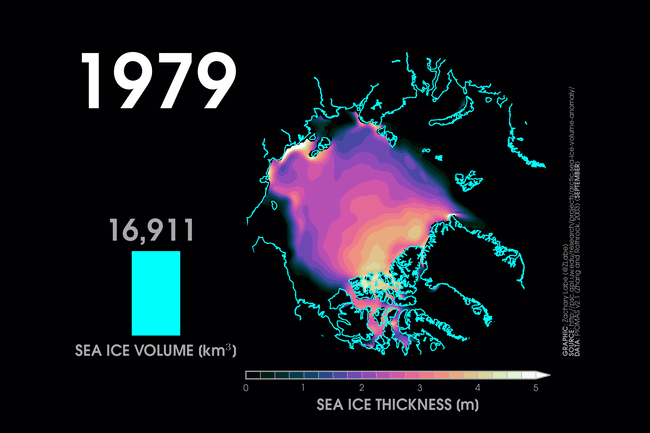A North Pole with Ice, how much longer?
When will the Arctic Ocean melt and what will be the impact for shipping and for the Earth?
Summary -In September 2020, ice volume in the Arctic Ocean was just one quarter of what it was in 1979. Climate science makes it clear that ice-free summers in the near future are inevitable. Most models suggest that this could could happen around the middle of this century, with more pessimistic forecasts suggesting total melting of the ice cap before 2035. An ice-free Arctic might be a boon for the shipping industry in the short term, but comes at potential catastrophic cost to our economy in the form of environmental disaster and political upheaval.
The disappearing of the North Pole, the melting of the Arctic (ice), a “blue ocean event”… These all come down to the same thing: a pivotal change in Earth’s climate with many possible disastrous side effects. It does provide shorter shipping routes from East to West though, which is great.
An Awe-Inspiring Place
The Arctic, also affectionately called the North Pole and home to Santa Claus, has always been a magical place that captivated our imagination. It was one of the last places on Earth that went unexplored, not due to a lack of trying but because of the almost insurmountable challenges of the harsh environment. Many explorers gave their lives here, such as the crew of the HMS Terror that set off in 1845 to search for the elusive Northwest Passage. None of them were ever to be seen or heard from again until the wreck was found at the bottom of an Arctic bay in 2016, aptly named Terror Bay.
“Perilous Position of HMS ‘Terror’, Captain Back, in the Arctic Regions in the Summer of 1837” by William Smyth R.N. This vessel would survive this journey, but not the one after that in 1845. The Arctic remains a true wilderness, mostly inaccessible for shipping due to the ice. Mostly inaccessible for the time being that is…
More recently, the situation surrounding the melting of Arctic sea ice has inspired me with a sense of terror as well. It is true that we have always heard ‘scary’ stories about sea ice disappearing and polar bears going extinct. Somehow it just felt far away, as if I would not experience it in my lifetime. After 2020 however, in which the Arctic was literally on fire, it felt to me like we had only have a few years left until the first ice-free summer can be declared in the Arctic.
Inspired by climate anxiety, I set out to do some 21st century exploring on the internet myself. In this blog I aim to figure out how much longer will we still have Arctic sea ice. Join me on this quest in which we start by looking into how the Arctic is doing, before making an overview of predictions on ‘when everything is gone’ by various renowned organizations. We end our journey by looking into the (potentially disastrous) consequences that follow from the melting of Arctic ice.
How is the Arctic doing?
It wasn’t always like this
Before we can start our journey however, we need to establish some sort of long-term baseline. What exactly is ‘normal’ in terms of Arctic ice? Because, to be fair, our Earth does not always have Arctic ice. In fact, it is more common for there to not be ice on the planet at all.
There have always been periods in Earth’s history with reduced or no ice in the Arctic, with the latest period perhaps being as recent as 6000-7000 years ago. When there is no sea ice and no continental glaciers whatsoever on the planet, it is commonly referred to as greenhouse Earth. This actually is the standard scenario for Earth: it is estimated that for 85% of Earth’s geological history there has been no Arctic (sea) ice whatsoever!
Despite what you might think, we are currently living in an icehouse Earth. This is a period in which the Earth has at least two ice sheets, the Arctic and Antarctic (one on each pole). The size of the ice sheets increase during so-called glacial periods, better known as ice ages. There have actually been ice ages in which ice covered a much larger part of the world. In fact, it is argued that there have actually been times in which the Earth was fully covered in ice itself. This is called the snowball Earth theory. A number of unanswered questions remain regarding this theory, including whether the Earth was a full snowball, or a "slush-ball" with a thin equatorial band of open (or seasonally open) water.
In short, details on Arctic ice on Earth are much contested. What is not contested however, is the importance of Arctic sea ice in our current climate. Even if Earth does not have had Arctic sea ice in most of its history, it plays a crucial role in regulating our current climate. Some have actually called the Arctic the world’s “air-conditioning system” because of the role of the large ice sheets in cooling the surrounding continents. And at this point in time, the air-conditioning is starting to fail.
Damage Report 2020
The current status of the ice leaves much to be feared. According to the National Snow & Ice Data Center (and virtually everyone else on Earth except for ‘CliMaTE SkePtiKs’) 2020 has been a record bad year. At the end of September 2020, ice volume was estimated to be just one quarter of what it was compared to September 1979. The monthly average ice extent for October 2020 was the lowest in the satellite record: well below 4 million square kilometers.
It does not really matter which source or graph you choose, they all boil down to the same conclusion: Arctic ice is vanishing. Fast. Ice extent is decreasing by almost 1 million square kilometers per decade. In climate science terms, the ice is considered gone when the of sea ice area coverage is less than one million square kilometers. Considering there is currently about 4 million square kilometer left, it would need to shrink to about a quarter of its current size. At this linear rate, it would therefore take about 40 years for there to be ice-free summers.
It is almost as if you can hear the Arctic air-conditioning unit crackling, huffing and puffing as it tries to compensate and grow new ice. And that is exactly where it hurts most: once there is no more multi-year ice, the Arctic is per very definition ice-free during summer and the unit is broken. And we are dangerously close.
A summary from the NSIDC shows how bad the situation was in autumn 2020. Arctic sea ice extent averaged for September 2020 was 3.92 million square kilometers, the second lowest in the 42-year satellite record, behind only September 2012. This is 350,000 square kilometers above that record low, and 2.49 million square kilometers below the 1981 to 2010 average. Following the minimum seasonal extent, which occurred on September 15, ice growth quickly began along in the northern Beaufort, Chukchi, and East Siberian Seas.
Looking at the situation during the time of writing in December however, we see that Arctic sea ice still has not recovered much. Sea ice extent remains far below average, dominated by the lack of ice on both the Pacific and Atlantic sides of the Arctic Ocean. As was the case for October, air temperatures averaged for November were well above average over much of the Arctic Ocean, notably over open water areas. Averaged for the month, total ice extent for November 2020 was the second lowest in the satellite record.
Here we have the ‘Arctic death spiral’, a not-so-nice name but great visual representation of yearly ice volume data on the Arctic. Once the number hits 1, the Arctic officially dieded. As you can see, this would first occur in September before gradually expanding to more months a year. Another sad detail: the current maximum extent of sea ice is almost the minimum from 1979.
Whichever fit you would like to use, linear, polynomial or other, the trendline is clear. Sea Ice extent is going down. Fast. Decreasing by 4 million square kilometers per 40 years, it would take only 40 more years for there to be no ice at all. Unfortunately, all kinds of positive (or negative?) feedback loops will cause this melting to possibly accelerate.
Why ice age and multi-year ice is important
Every year, Arctic sea ice has its “birthday”. This is the the time of the year when the minimum sea ice extent is reached, which usually happens mid-September. With the minimum reached, the remaining sea ice that survives the year has had its birthday, aging one year. Ice that survives for at least one year is called multi-year ice, sometimes perennial ice, which gives an indication of the health of the ice at the end of the melt season. The more multi-year ice, the better it is for the Arctic.
In September 2020 the extent of the oldest ice (4+ years old) was 230,000 square kilometers, slightly more than 5% of total sea ice. This is considerably higher compared to 2019, when the 4+ year old ice extent stood at 55,000 square kilometers. Overall since the 1980s however, sea ice has become much thinner and younger. Back then, oldest sea ice covered over 2 million square kilometers of the Arctic Ocean, almost 33% of overall ice.
What happens when this multi-year ice is gone? Just have a think. When there is no more multi-year ice then, well, there is no more ice surviving the summer. That means we will have ice-free summers. So the question is, how fast can this happen?
The left map shows sea ice age distribution toward the end of the melt season for 1985 and the middle map shows the end of the 2020 melt season. The chart at the right shows the time series of different age categories, depicting the minimum extent for 1985 to 2020. Note that the ice age product does not include ice in the Canadian Archipelago. Data from Tschudi et al., EASE-Grid Sea Ice Age, Version 3. Credit: W. Meier, National Snow and Ice Data Center and M. Tschudi et al.
This short clip shows an amazing animation of the disappearance of multi-year sea ice, elaborated upon by Professor Peter Wadhams ScD, a professor of Ocean Physics, and Head of the Polar Ocean Physics Group in the Department of Applied Mathematics and Theoretical Physics, University of Cambridge. He is best known for his work on sea ice.
So. How much longer will we still have Arctic sea ice?
Your kids probably will not have ice in Summer
We might not now exactly which year, but we do know exactly which month it will happen for the first time. It will start in a September, the time of the year with the lowest Arctic sea ice extent. It will most likely be just a few weeks, perhaps even just a few days, at which the Arctic is declared “ice-free”. In climate science terms, this means Arctic sea ice extent is less than one million square kilometers.
But what year is it?!
All bets are off on this one. And of course, the answer is highly dependent on who you ask. There are a lot of revered institutions, scientists and organizations pointing towards this happening within the next 30 years, with some going as far as to say it might happen within ten to twenty years. Others are more conservative and point towards the end of this century. None of them however are disputing the evidence and all of them agree that it will happen sooner than we might realize. From the chart below, it can be seen most point towards it happening within a single generation. At some point however, you can argue whether it really matters. What if the amount of ice extent reaches 1.1 million square kilometers? Is it then still ok? For some, discussing when it will happen is a mute point. Some argue to accept the inevitable and start preparing for the worst.
What will happen when the Arctic is gone?
Whether it will be 2100 or 2035: the Arctic is melting. it is for real. The question to be asked some argue, is not when ice will be gone, but what will happen after?
This abstract and broad question can of course be answered by throwing our hands in the air and saying “we don’t know”. We do not have enough data on it yet and our models can only venture a guess. Then again, some things are not so hard to imagine as they are rooted in common sense and basic science. We have listed 10 potential outcomes below, ranging from what is most likely to occur to what is least certain.
+ 1. Ice-free shipping lanes
Probably the only positive outcome on this list - at least for the short term - is the boost to shipping when an ice-free Arctic finally occurs. With the Northern sea routes available all year, costs for transporting goods will go down significantly, leading to more economic activity. For journeys between Europe and Asia, the Northern Sea Route can already be two to three weeks faster than the Suez Canal. And it is not just the shipping route along Russia’s north coast that has sat at the center of discussions on Arctic development for the better part of two decades now. The shrinking and thinning of sea ice is happening so fast, people are talking about a trans-Arctic passage cutting straight across the North Pole.
According to the Arctic Marine Shipping Assessment, if Arctic sea ice disappears even for just one summer this would spell “the disappearance of multi-year sea ice in the central Arctic Ocean. Such an occurrence would have significant implications for design, construction and operational standards of all future Arctic marine activities.” In the absence of thick multi-year ice, which can be up to five meters deep, any water that refreezes would take the form of much thinner, more navigable seasonable ice. Good news for boats, bad news for polar bears.
Especially the transpolar sea crossing has a great benefit for ships: they would not have size restrictions. The Central Arctic Ocean’s bathymetry isn’t as limiting as the Northern Sea Route or Northwest Passage, which is only 50 meters deep or so in many places. Once out of the Arctic Ocean, cargo could be transshipped from places like Dutch Harbor to ports along the North Pacific, or, on the other side, from a place like Iceland to ports along the North Atlantic.
Fast shipping isn’t everything, of course. Besides time, shipowners also consider risks and costs, and polar shipping still is a more dangerous and pricier undertaking due to more advanced types of ships required, insurance costs, and icebreaker escort fees. These icebreakers would not be needed much longer however.
Within the next few decades, at least in summer, sailing across the top of the Earth will occur even if insurance companies and the Polar Code still mandate polar-class, ice-resistant ships. Like the zeppelin and the Concorde before it, icebreakers will become a futuristic technology lost to history. Their early demise won’t be due to technological or financial failures, however, but rather because humankind made the surfaces it traversed obsolete.
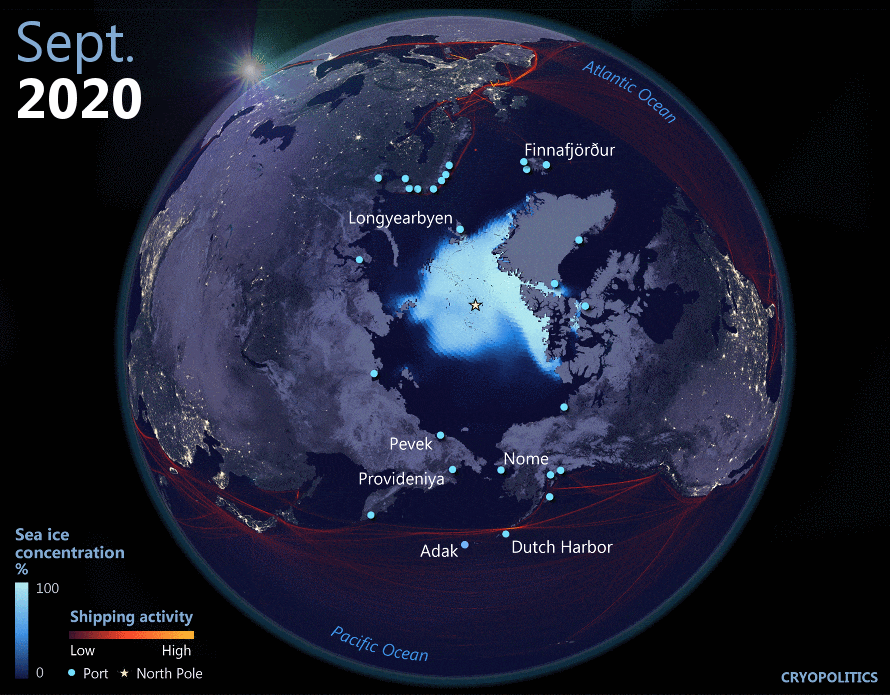
+ 2. The Earth will absorb more heat
As long as there is ice in a body of water, any surrounding heat energy is carried towards the ice to make it melt. But the energy needed to make it change state (or phase) from solid to liquid is the same amount of energy that would heat a similar body of water all the way up to 79 degrees Celsius. In other words, the Arctic can store a lot more energy and heat when there is no more ice coverage. Once all the ice is gone, the water gets much warmer much quicker.
This effect is explained clearly in this article by Discover Magazine. Walt Meier, a senior research scientist at the National Snow and Ice Data Center, explains that “the main factor is ocean heat.” In September 2020, sea surface temperatures in the Laptev Sea off Siberia climbed higher than 5 degrees Celsius. "That’s insanely warm for the Arctic Ocean, especially in that region, far away from any warmer inflow from the Atlantic or Pacific," he says. Meier notes that winds and waves have mixed some of that heat down into the water column. For ice to form on the surface, heat needs to be lost to the atmosphere. "So that’s where we are now," he says. "The ocean still has heat, so ice is not yet forming. And that heat is going into the atmosphere."
Trapped heat can cause a tipping point after which things start to snowball. No pun intended. The heat that goes into the water while the ice was missing will make it extremely likely that the ice will remain missing forever after. Once multi-year ice is gone it is extremely hard to get it back. Arctic sea ice will never have a birthday again as it will not survive the summers. #Sad.
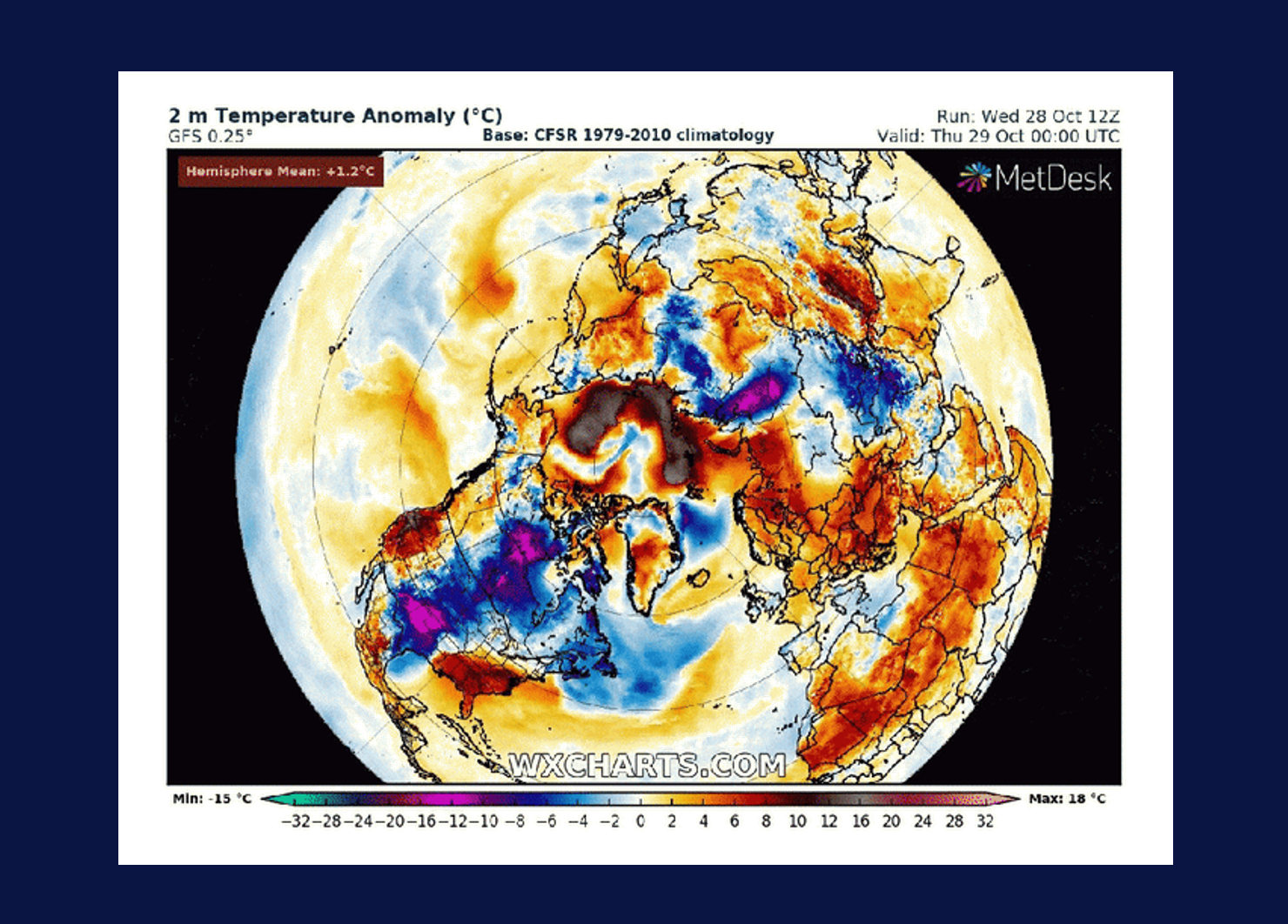
+ 3. Greenland will melt faster
Once all the ice goes, you no longer have a nice white sheet of ice that bounces much of the energy of the Sun back into space. In fact, the solar energy is absorbed far more easily by the liquid water, which means even more energy will be stored into the Arctic region. This could lead to yet another negative feedback loop that could wreak havoc on the Arctic, drastically increasing the melting of not just sea ice but also Greenland's ice-sheets.
Even though the Greenland ice sheet is on land, it is connected with the Arctic sea ice. The rapid warming of a content-sized body of water right next to you will have an impact. For Greenland, it means that ambient air in the region will also be getting warmed up. That warmer air will flow over Greenland, which will accelerate the melting of the Greenland ice-sheet.
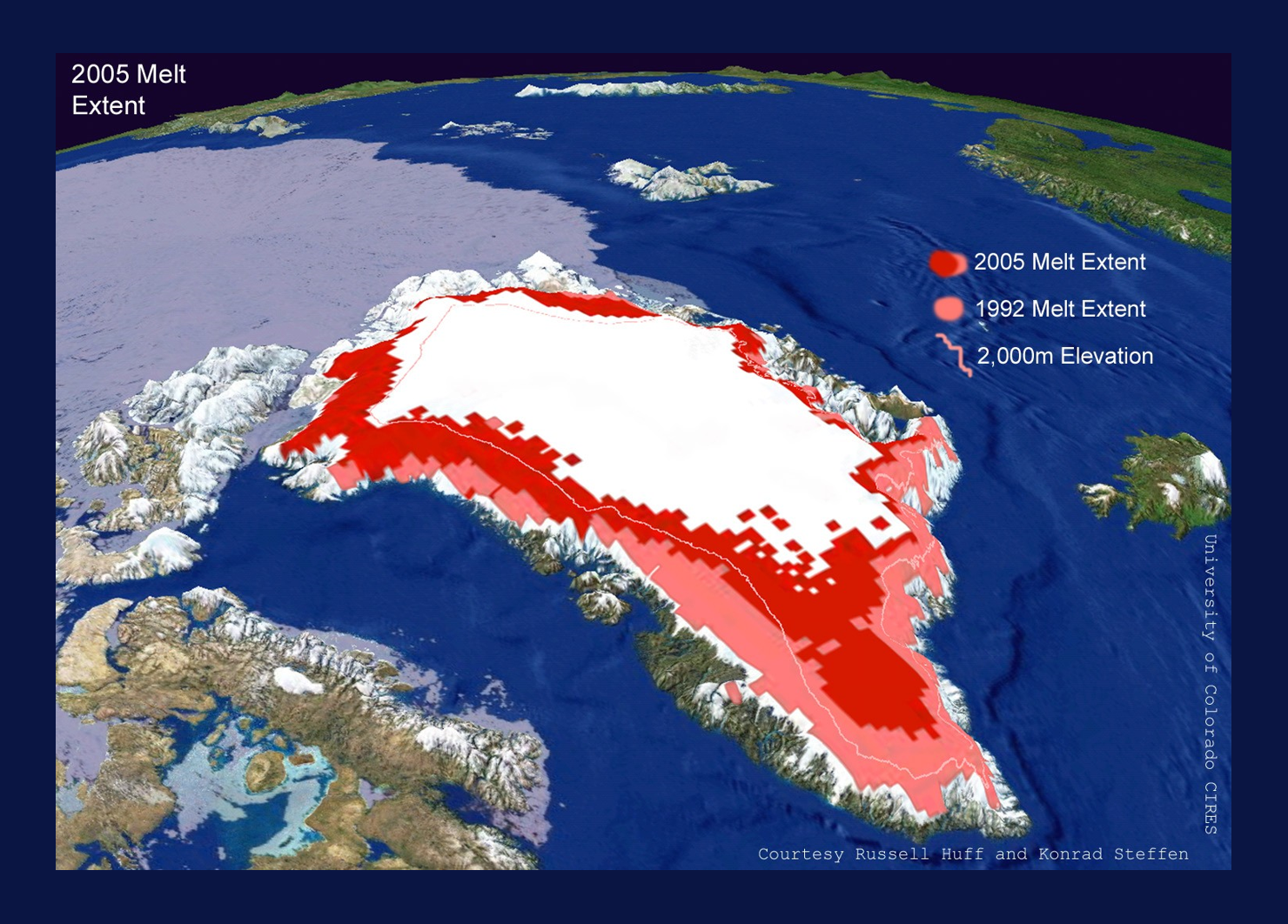
+ 4. More frequent and heavier storms
With Arctic sea ice gone and accelerated melting of the Greenland ice-sheet, you can rest assured that water vapor in our atmosphere will increase. Coupled with an increase in temperature, this effect will be even stronger. Physics tells us that for every 1 degree Celsius of warming, our atmosphere can hold about seven percent more moisture. This leads to - you guessed it - yet another feedback loop.
As water vapor itself is a potent greenhouse gas, more water vapor in the atmosphere means accelerated global warming. And it will not only be regional. Because of the interconnectedness of our global climate system, this effect will be felt everywhere around the world. Simply put, the additional energy will lead to there being more energy available for storms and hurricanes globally, drastically increasing the amount and severity of deadly storms.
We are already feeling the effects of this. As a sort of reminder that this was already the year from hell, 2020 has seen the most storms in the shortest amount of time in recorded history and we 'ran out of hurricane names'. The amount and intensity of storms is only expected to increase.
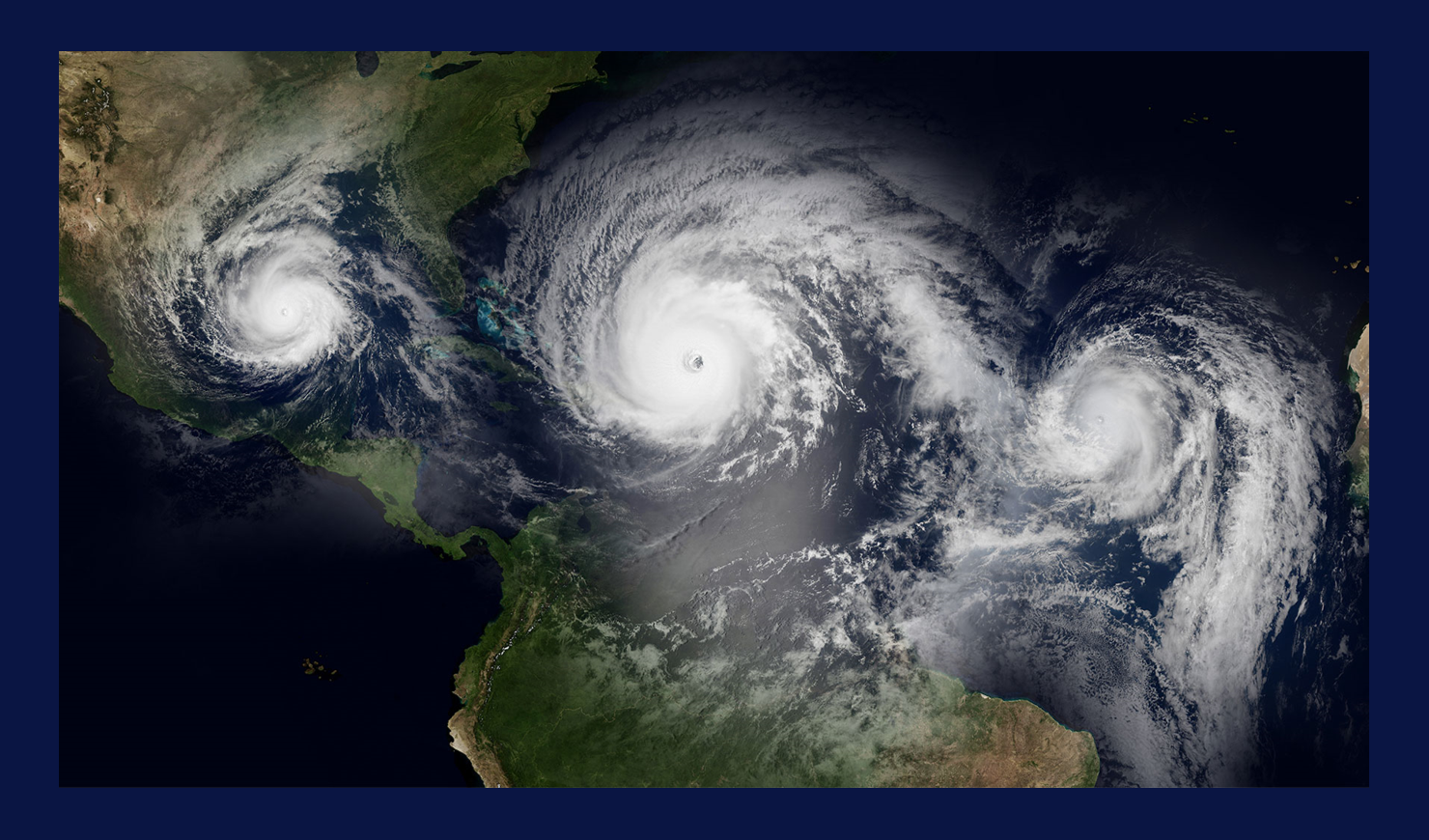
+ 5. Sea level rising (not because of melting sea ice)
Naturally the ice which is ‘floating’ in the Arctic will not directly impact sea levels when it melts. It is due to another physical aspect of matter: water will expand when heated. Combine this with the ever-increasing rate of melting of the Greenland ice-sheet, which will flow down into the sea, heat up and expand in itself. These two things will cause the sea levels to rise. Not just in the Arctic, but all around the globe.
Coastal areas, especially those below sea level already, are expected to be mostly effected. Rising sea levels is nothing new of course, but after the Arctic is gone we will stop talking about tenths of millimeters a year and we will talk about tens of centimeters per decade or so. It can take decades before we might feel this effect, but when this happens it will cost us dearly. As someone coming from the Netherlands, this is something I feel we should be taking more seriously.
We Dutch are well-known for fighting the sea, but I feel we have taken our current safety for granted. The Netherlands' history is built on floods. After the flooding of 1953, the most recent in history in which 1835 people drowned and 9% of Dutch farmland was flooded, it took the Dutch more than 40 years to built the Delta Works. These are a series of protective dams, sluices, locks, dykes and storm surge barriers located mostly in the coastal areas of the Netherlands. The Dutch now feel safe behind this ‘impervious’ wall to keep out the sea. The thing is: the Delta Works have not been designed for a 2-meter rise of sea levels, a scenario the Dutch Royal Meteorological Service claims is not only likely by the end of this century, but will certainly break the defenses during a regular storm. We are sitting on board a Titanic, having a glass of champagne in first class and feeling perfectly safe while the ice-berg is right ahead.
+ 6. Regional cooling due to jetstream disruption
The average temperature of the Northern most parts of the world has already risen by 2 degrees Celsius in the last 30 years, much faster than the rest of the planet. That means the differences in air temperature between the Northern regions and the lower-latitude regions decreases as well. This causes the polar vortex to slow down and meander about much more than usual.
In laymen terms, this means that relatively (very) cold air from the Arctic will be blown more easily towards lower regions such as Europe and the U.S. This leads to things like the Beast from the East in Europe in 2018, where large parts of Europe were completely frozen to a standstill causing over a billion euros in damage. Paradoxically enough, a very hot Arctic will lead to some very cold weather down south.
On the upside, could such an event be our last chance for one final elfstedentocht in the Netherlands?
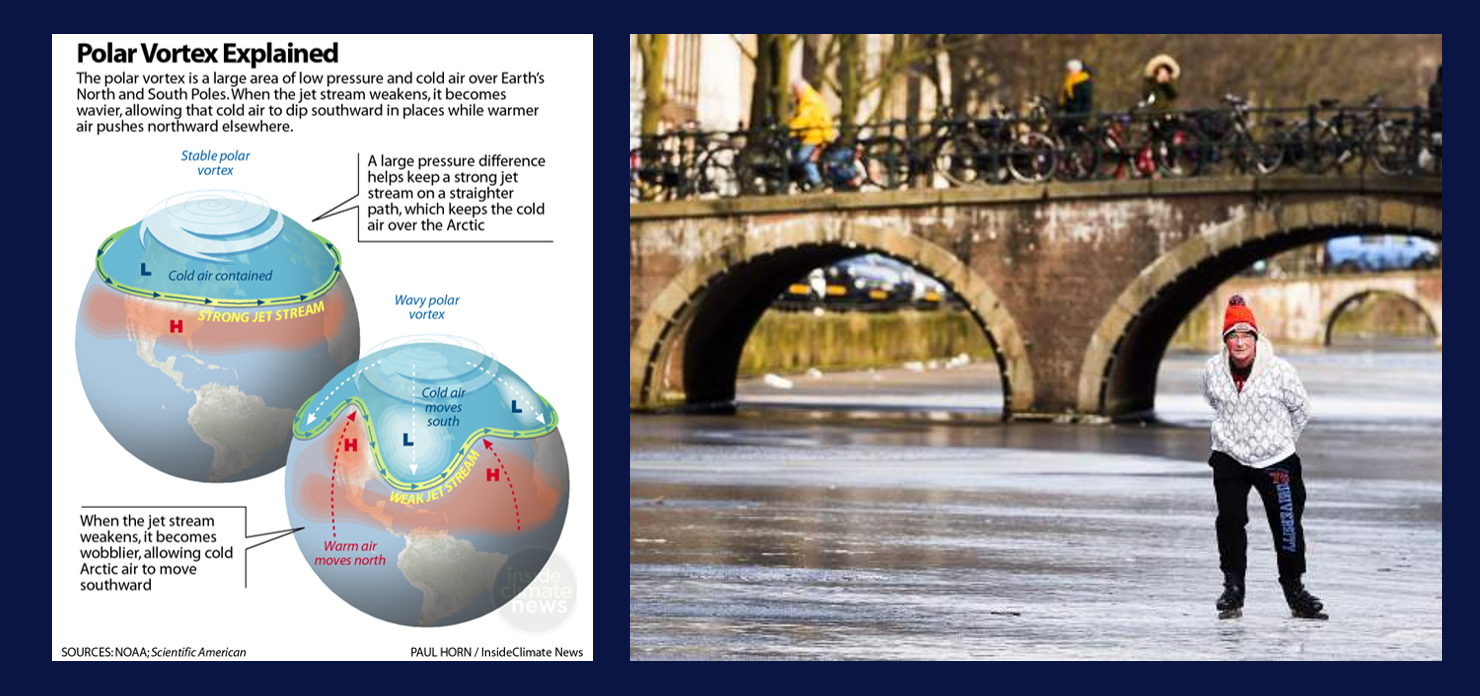
+ 7. Methane. Lot’s of Methane.
Some of you might already be aware of the ticking time bomb called methane. This ‘active ingredient’ in natural gas is up to 28 to 84 times more potent than carbon dioxide as a greenhouse gas. In 2008, scientists found that a giant amount of methane (about 50 gigatons) is trapped in the form of permafrost in Arctic regions. With the melting of permafrost in these regions, the methane will be released into the atmosphere, triggering yet another ‘positive’ feedback loop to further accelerate Arctic melt.
Instead of it being released gradually in the coming decades however, it could be released suddenly and almost all at once. This happened before during Earth’s history. In two extinction events, the Permian Mass Extinction and the Paleocene-Eocene Thermal Maximum, methane was almost certainly one of the drivers of climate extremes so severe they killed off most life. So how would humanity fair under these conditions?
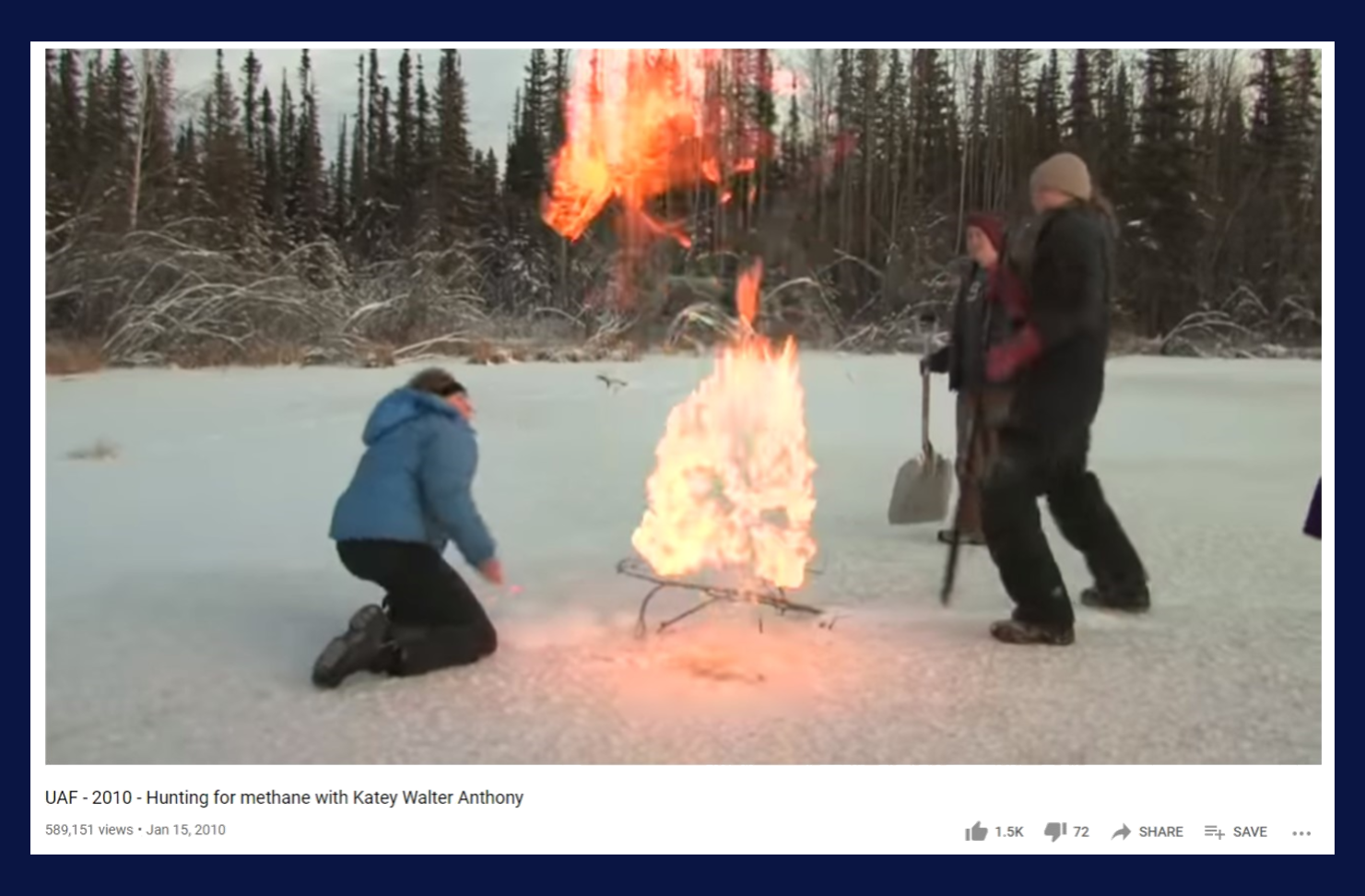
+ 9. Global (temporary) food shortage and climate refugees
It is not hard to imagine that with such significant changes to the atmosphere and climate in many places, the food and supply chains we currently have in place to feed ourselves will be wrecked. Several vital food-growing regions in the world will experience such severe temperatures that existing crops will be significantly impacted, yield reduced or simply destroyed completely. These areas include the U.S. mid-west, parts of China, India and South-East Asia, Africa and South America.
What’s worse: we are reliant on a very slender threat of genetic diversity. According to the U.N.’s Food and Agriculture Organization (FAO), more than 50% of all human calories come from just three plants: rice, maize and wheat. The impact of even a small climate shift in one of the main bread, rice or popcorn baskets of the world could therefore be catastrophic. On the upside however, it will also mean that entirely new areas will become available for agriculture. Enormous swaths of land in the same places so drastically effected - Siberia, Canada, Greenland - might just become hospitable for these important plants to grow. One could argue that potentially even larger areas become available for agriculture than those we had before. There remains one large caveat; all farmlands and the entire supply chain has to be made first, which could take the work of at least a generation. Consequently, there is no escaping global food shortages in the short run.
These food shortages, reminiscent of medieval times, will trigger another humanitarian disaster: climate refugees. Some have actually argued that the political instability throughout much of the middle East over the last decade and the refugee problem Europe is already facing, might be a harbinger of things to come. Mass movement of hundreds of millions of people worldwide will inextricably cause economic and social upheaval that we have not seen since the second world war. Which leads us to the last (and perhaps final?) outcome of an ice-free Arctic: global conflict.
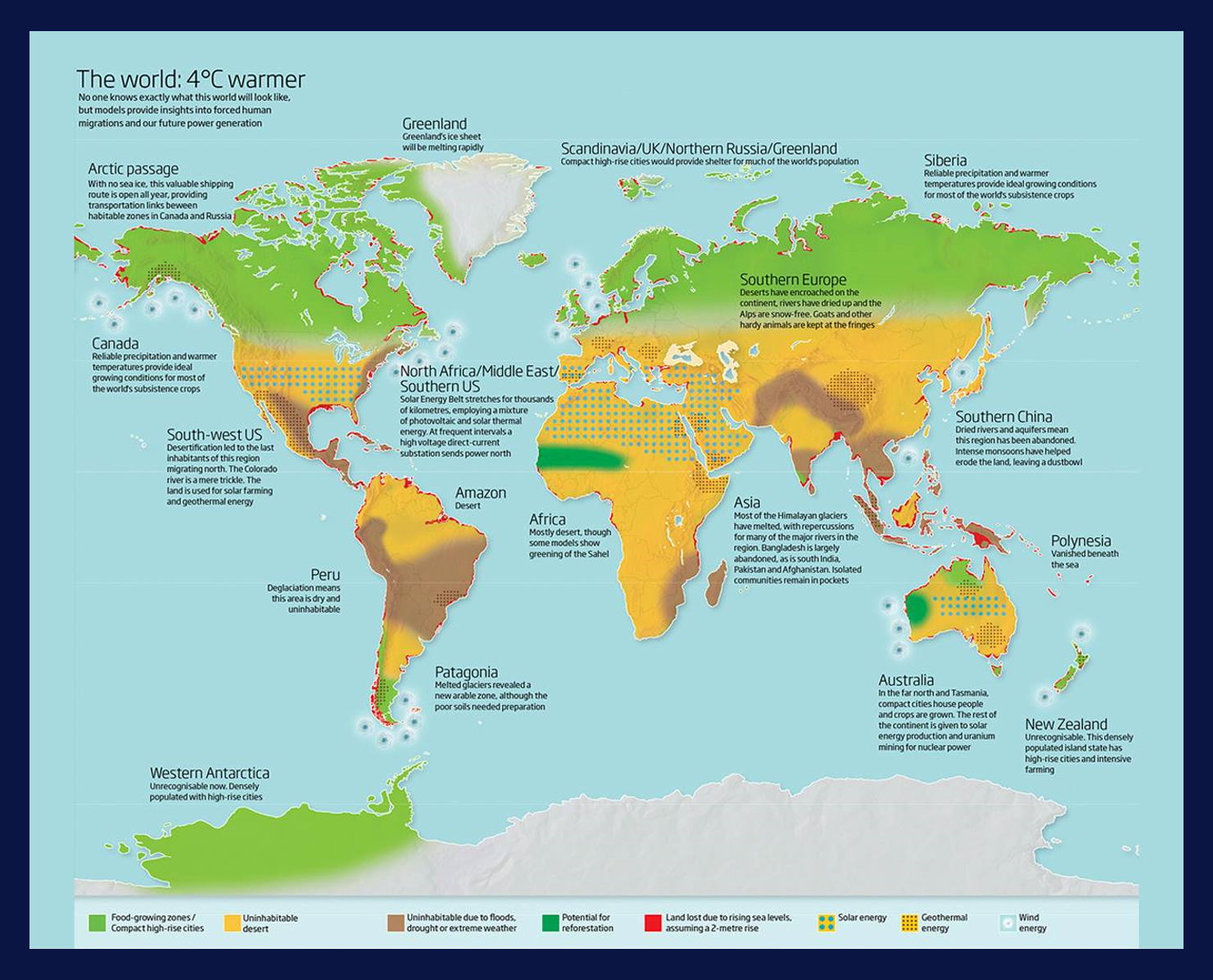
+ 10. Global conflict and geo-political upheaval
It is but a small step to go from global food shortage and refugee crises, to global conflict. As history all too kindly shows us, these types of crises have the tendency to lead to all-out war and civil unrest. Since Roman times, mass movement of people and famine have triggered the fall of civilizations. Most of us feel protected and have never felt how it is to not eat for days, or having no foreseeable outcome of food. With whole continents slowly starving and cut off from fresh water supplies, it is but a matter of time before societies start collapsing. Talk about some genuine positivism here, jeez.
Santa will Innovate or Die
Our journey has come to a rather sinister end. Climate science makes it clear that a seasonally ice-free Arctic in the near future is virtually inevitable. Even though it is more common for Earth to not have Arctic sea ice, it is a damn shame we are about to lose it. Plus, it is not Earth (or the polar bears) we have to worry about, it is the people on it who will bear the brunt of it.
Though I am mostly positive about our survival, as I know that everything on this planet will innovate or die, I am also saddened. Like almost everything in this social-media era, I think the disappearing of summer sea ice will be contested. You can rest assured that there will be a debate in the near future about whether or not ‘the Arctic is really gone’. CliMaTE SkePtiKs will say it’s fake, all the while the Arctic is vanishing from beneath our eyes.
Then again, this might be one of the most visual pieces of evidence for some critics to be converted and change their behavior. Most humans need a crisis to serve as an accelerant to change. We need a literal wake up call in order to realize the truths of our behaviors. Disappearing sea ice might do the trick. It is just a bloody shame we had to let it come so far.
Personal note
I believe we will see the first ice-free arctic (a sea ice extent of less than one million square kilometers) before 2035. As much as I do not like to be wrong, this is something I sincerely hope to be wrong about in the future.
And yeah sure, I am not a climate scientist. I only had a few courses in ocean and arctic engineering during my studies. Back in 2009, for my minor in Space and Earth Observation on the TU Delft, I wrote an article about a virtual satellite constellation for Arctic ice changes. More than ten years ago, it was already clear that ‘although the central parts of the large ice sheets appear stable and in balance, dramatic changes are taking place around their more dynamic margins, especially in Greenland.’ Eerily enough, the trends I predicted are coming to fruition: the decline of perennial (multi-year) sea ice and a rapid decline of overall sea ice coverage will lead to ice-free summers in the Arctic.
As there was then however, there is now still much skepticism about the exactness and details of the data provided by the most importantly recognized institutes of the world, such as the NSIDC, NASA and ESA. At the moment, I have trusted these organizations over the few climate deniers but it is still interesting to read their ‘arguments’. Especially how they try to decouple reality and data. Then again, I might be doing the same thing: trying to find arguments to defend my case. Whichever outcome might happen, the trends worry me deeply.
What worries me most, is reaching one of the above-mentioned tipping points that lead to irreversible humanitarian disaster. What triggered me most when writing this article however, was not just the potential for environmental catastrophe and negative feedback loops that might already unstoppable. Sad as pictures from starving polar bear may be, it is the effects on human life which I fear the most. Especially as a person already living below current (not even future!) sea levels.
I therefore see a clear imperative to change my own behavior. Even if it is ‘just me’, I will do what I personally can and want to revert or stop the melting as much as possible, including eating (less) meat, in particular red meat, fully carbon neutralizing my home and my entire life at some point, plus decarbonizing the company I work for from within and leading them on a more sustainable path. Everything that I can and willing to do, I should do. Pointing towards the bad behavior of others does not make the problem go away, and working hard to make stuff sustainable is what I came here to do.
References & Further Reading
Mr. Sustainability - A Front-Row Seat for the Arctic’s Final Summers With Ice
V.H.R.I. Doedee - Virtual Satellite Constellation for Arctic Ice Changes (2009)
Elsevier - The Increase in the Length of the Ice-Free Season in the Arctic by J. Rodrigues (2009)
Nature - The Arctic is burning like never before — and that’s bad news for climate change
Scientists’ Warning - Blue Ocean Event
NSIDC - Quick facts on Arctic sea ice
NSIDC - Arctic sea ice news & analysis
NASA - 2020 Arctic sea ice minimum at second lowest on record
Faster Than Expected - Multi Year Ice in the Arctic is Nearly Gone
Marine Executive - The Arctic Shipping Route No One’s Talking About
Discover Magazine - "Insanely Warm" Arctic Ocean Waters Are Delaying Freeze-Up and Pouring Heat Into the Atmosphere
Wikipedia - Ice-Albedo Feedback
National Geographic - We've run out of hurricane names. What happens now?
Wikipedia - Delta Works
Just Have a Think - Polar Vortex. What? Why? How?
The Times - ‘Beast from the East’ caused by freak Arctic heatwave
Before the Flood - The Ticking Time Bomb: Methane
FAO - Staple Foods: What do People eat?


